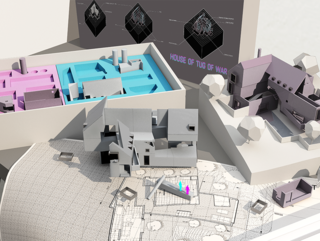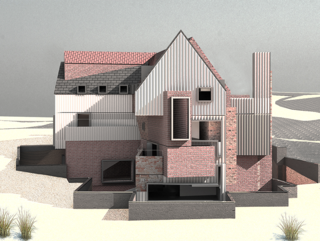
The Family Portrait: Drama is the Diagram
401 Advanced Topics Studio
2020
The Miller House, located in Lexington, KY, is a house by architect José Oubrerie completed in 1992. So the story goes, Mr. and Mrs. Miller were no longer on speaking terms with their two sons, and the two sons were neither talking to their parents nor with each other. There was a three-way domestic diagram between the three units within the household - a completely broken set of relationships, a disconnected bond. Yet, the commission of Miller House was conceived of with all members of the family in mind. As a response, Oubrerie designed the Miller House as three separate houses with their own entries and exits, but bounded together by a shared living room as the connective tissue that physically held the fragile house together. The living room, seldom occupied by anyone, became the loneliest space where all three family units turned their backs on it. In the Miller House, José Oubrerie did not only design a house for the Miller family - he used architecture as a medium to paint an accurate family portrait of an irreparably dysfunctional kinship. The family drama, rather than an obstacle to work around, became the driving narrative that generated the diagram of the Miller House.
Family drama, though commonplace and seemingly insignificant, is as old as human history and as impactful as culture-defining works of literature. Some of the most archetypal tales we still pass on today are conflicts within the household. The disloyal Zeus fathers Hercules out of wedlock against the wishes of a betrayed Hera, Abel was senselessly murdered by the hands of his own brother Cain, or the senile King Lear who grew blind to both the faithfulness and the treachery of his three daughters - these canonical lores we continue to disseminate are just some of examples of family drama that helped characterize humanity. Architecturally, family drama could imply more ways to think about the building that shelters such turbulent relationships. From the decision to share or withhold certain amenities (estrangement), the switch of materiality to change acoustic qualities (secrecy), the voyeuristic relationship for the sexes to spy on one another (jealousy), the location of fireplaces or television sets to disrupt the idea of centralized gathering points (control), the shifting up or down in elevation points of the interior to create high grounds (power), to ways in which windows frame, cut, and broadcast the drama (exhibit) - architecture is the medium to paint the family portrait.
In 2020, the global pandemic COVID-19 has forced many people to work from home. As a consequence, almost every domicile has had to experience some degree of heightened exposure with family members, where the 24-hour cycle now represents a fully saturated time spent continuously. This increased togetherness could either be a healing space to ameliorate existing issues between family members, or a pressure-cooker to rapidly intensify past drama. 2020 is also an election year - one where the already tumultuous American politics could potentially be brought home and gets the time and space to be cultivated into further flashpoints for internal conflicts. The health of the society has direct consequences on the health of the household.
This studio explored single family homes. Reflecting upon family drama, students generated organizational diagrams that reflected the health of the family, wrote archetypal arcs, and represented the narratives with storyboards of the house. The houses of the studio were be sited just outside the coastal village Cambria, CA.
Related Faculty |
Jimenez Lai |






- Cullen Fu
- Cullen Fu
- Cullen Fu
- Cullen Fu
- Cullen Fu
- Cullen Fu